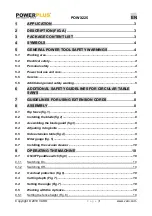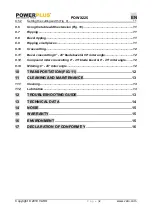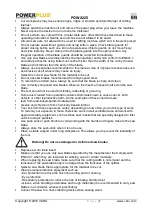
POWX225
EN
Copyright © 2019 VARO
P a g e
|
9
www.varo.com
▪
Remove the outer flange and pull the old saw blade from the inner flange, with a
diagonally downwards movement.
▪
Carefully clean the saw blade flange with a wire brush before fixing the new saw blade.
▪
Insert the new saw blade in reverse order and tighten it.
Warning! Observe the rotational direction; the teeth have to point in the
direction of rotation, i.e. forwards.
▪
Attach the table insert (5) and the saw blade guard (6) again and set them.
▪
Before working with the saw again, check the functionality of the guards.
8.3
Assembling the blade guard (fig 3)
▪
Place the saw blade guard (6) including the bolt (a) on the riving knife (9) from above so
that the bolt is tight in the slot of the riving knife (9).
▪
Do not tighten the bolt (a) too much; the saw blade guard (6) must be able to move freely.
▪
Place the extraction hose (b) on the extraction adapter on the rear of the machine and on
the extraction nozzle of the saw blade guard (6).
▪
Disassembly takes place in reverse order.
Warning! Before starting to saw, lower the saw blade guard (6) on to the
work piece.
8.4
Adjusting riving knife
There must be a clearance of about 5
– 6 mm between the riving knife and the blade teeth
when pushing riving knife toward the blade fully. Adjust the riving knife accordingly by first
loosening clamping nut by hand counterclockwise and then loosening hex bolt
counterclockwise with the hex socket wrench, and measuring the distance. After adjustment,
securely tighten the hex bolt and then the clamping nut clockwise. Always check to see that
the riving knife is secured and that the top blade guard works smoothly before cutting.
The riving knife has been installed before shipment from the factory so that the blade and
riving knife are in a straight line after your simple set-up. Refer to the section titled
CAUTION:
▪
If the blade and riving knife are not aligned properly, a dangerous pinching condition may
result during operation. Make sure the riving knife is positioned between both outer ends
of the blade teeth when viewing from the top. You could suffer serious personal injury
while using the tool without a properly aligned riving knife. If they are not aligned for any
reasons, always have an authorized service center repair it.
▪
When adjusting the riving knife clearance from the blade teeth, always loosen the hex bolt
only after loosening the clamping nut.
8.5
Side extension table (fig. 4)
▪
The table width extension (8) should always be used for particularly wide work pieces.
▪
Loosen the locking handle (a) and pull out the table width extension enough so the work
piece can lie on it without tilting.
8.6
Miter gauge (fig. 5)
▪
Push the miter gauge (4) into a slot (a/b) on the saw table.
▪
Loosen the locking handle (c).
▪
Rotate the miter gauge (4) until the required angle is set. The scale (d) shows the set
angle.
▪
Re-tighten the locking handle (c).


































